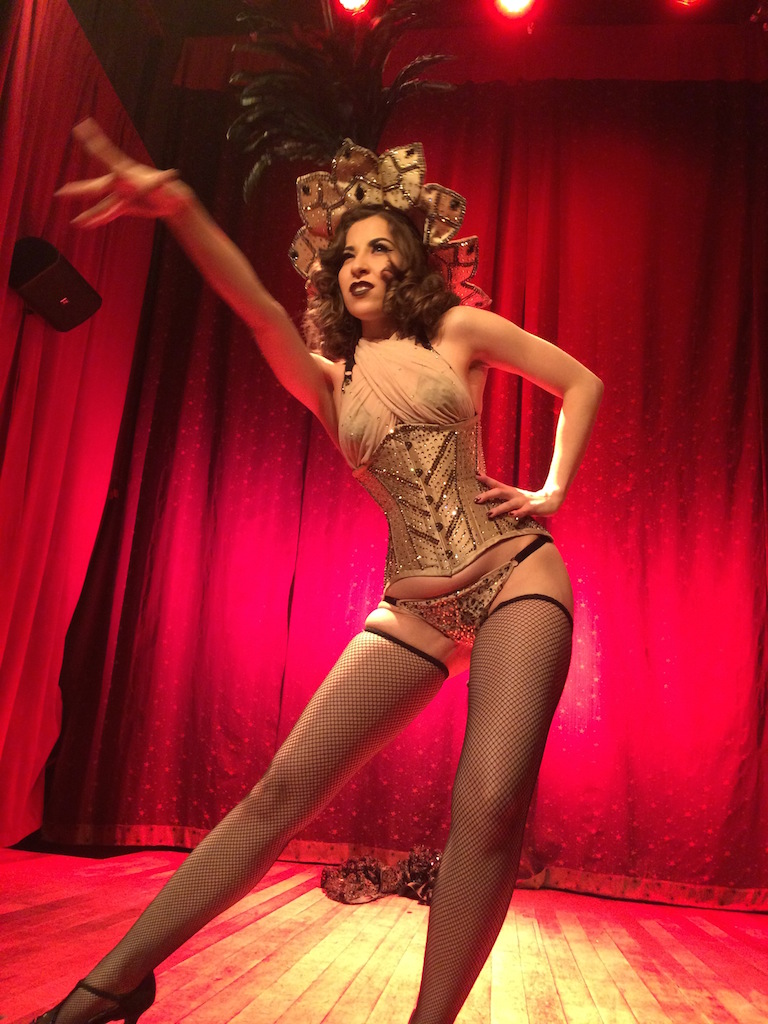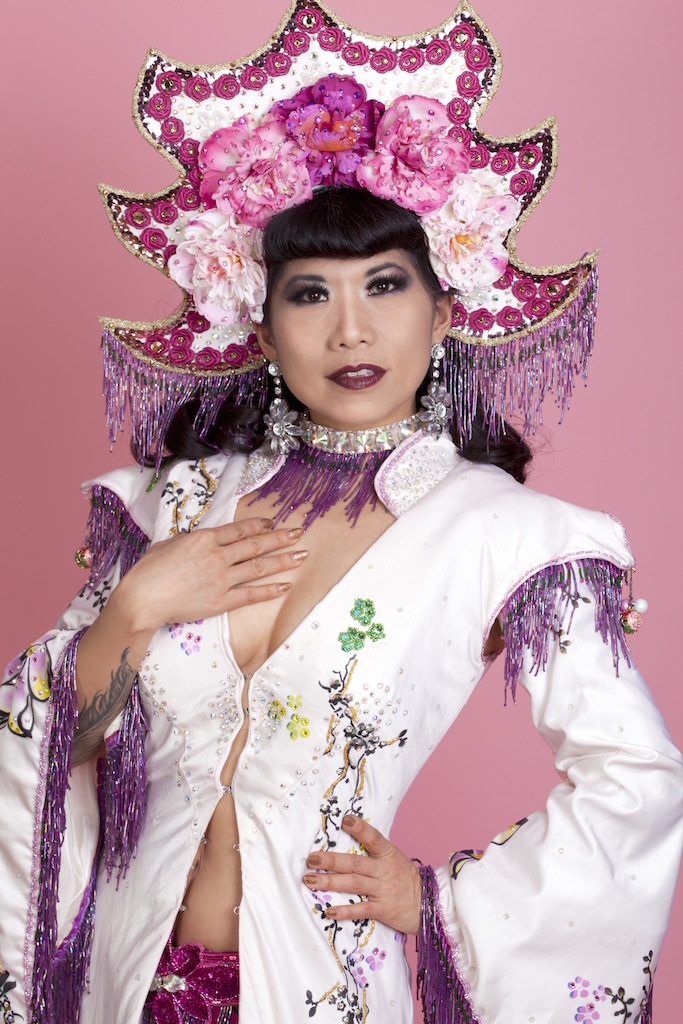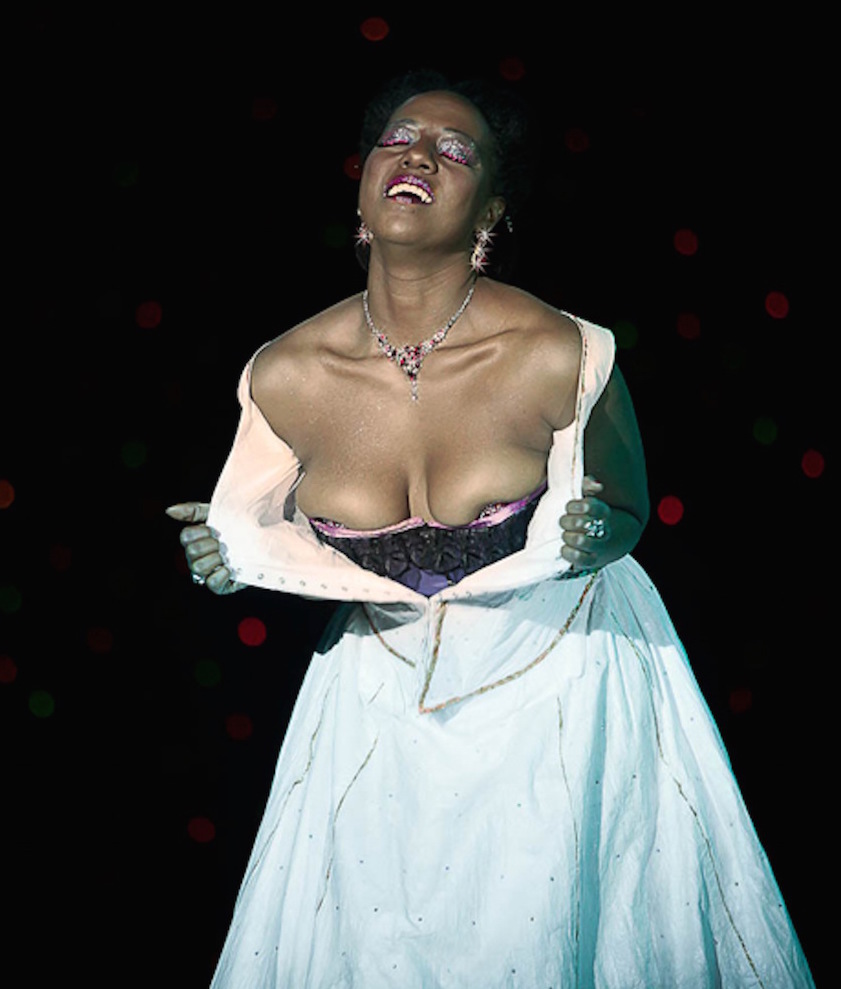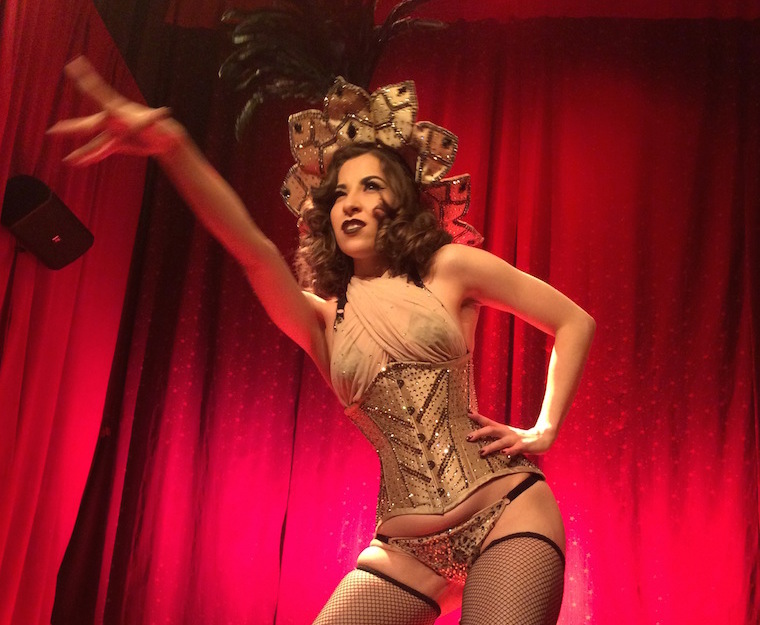BY NOAH KLEIN | You are in the Slipper Room on Orchard St. on the Lower East Side. It’s a sensuous-looking performance space. Its decor some have likened to a bordello. There’s a stage at the front. The red velvet curtain is thick, closed to all not privileged to enter backstage. Illuminated in a soft glow, a bar is at the right side of the room. At its corner, two women — in colorful shawls and sequined dresses, their hair tied up in intricate curls, the corners of their eyes dotted with rhinestones — drink amber colored liquid from clear glasses.
Hovey Burgess, an artist-in-residence at Tisch School of the Arts, where he teaches circus techniques, sits at a table up front, in his usual spot, near the corner of the stage. He sips his Coke in his red shirt and signature rhinestone bow tie.
Lily Faye a.k.a. the Bronx Bombshell walks out on stage. “My Daddy Rocks Me,” a rollicking 1920s jazz tune, pumps through the speakers. A seamstress as well as a performer, she designed her red robe, sewed the feathers down the front and across the shoulders. Each stitch is an essential part of her performance, as much as her first step onto the stage to the first smooth trumpet note of the song.

A long, dark-haired and dark-eyed Latina, she controls the stage with each lunge, each smile and each choreographed, sinuous movement. Those movements and her expressions have been honed over her three years of performance experience: the bold, fluid forward thrust of her right leg, the slit opening slow, like the foreboding red curtain, revealing a well-toned thigh; the slight smirk that lifts the corner of her mouth; the graceful, powerful motions of her arms as she sheds the outer layer of “cloth of fire”; a surprised open mouthed “oh” when the first glove comes off revealing skin.
Another night, another venue on the Lower East Side: a classic 1920s French hotel design, complete with a Parisian rooftop garden and an elegant lobby bar. From the copper-plated ceiling, to the red velvet booths, Hotel Chantelle oozes a sultry, jazzy elegance. You glance at a woman standing in a semi-hidden room across from the bar. She looks completely at ease and in control in her blue, rhinestone dress, her long white gloves, her white, feathered boa and white feathered hat — her general’s uniform.
She is a legend in the scene — eight years as a performer and producer, she has earned the respect and admiration of her peers and the adoration of audiences across the world. Calamity Chang a.k.a. the Asian Sexsation of classical burlesque, and a “burlesque maverick,” according to fellow producer and performer Chicava Honeychild, has a larger-than-life presence on and off the stage. Her personality: a battering ram of raunchy jokes, charming smiles and witty banter.
Finish your Tito’s vodka martini dirty at the Chantelle’s rooftop bar and stroll over to Nurse Bettie, a small, intimate, back-alley venue on Norfolk St. The space is cramped, packed with people — yuppies, hipsters, financiers and, of course, a random assortment of bar hoppers who stumbled into the right place at the right time. The free Thursday night show, first started by Calamity Chang, begins.

Calamity, co-hosting with the “Golden Throat of Burlesque,” Broadway Brassy, steps on stage: “Give a burlesque welcome to Chicava Honeychild!” Wolf whistles, hollers and raucous applause (all are always encouraged) follow.
A tall, black woman — all tightly coiled sexuality and utterly comfortable in her “not the American ideal” body type — claims the small raised stage for her own. Chicava, who started performing in 2006, joined Brown Girls Burlesque in 2007, and started producing for them in 2008.
All three women share the qualities of being highly educated, ambitious and of color.
Lily Faye has a B.F.A. in women’s intimate apparel with a minor in art history from The Fashion Institute of Technology.
When asked about her ultimate goals in burlesque she states, “Performing is not my number one occupation. I am a lingerie designer and seamstress and plan to start my own company.”
However, she acknowledges, “Burlesque has helped me in my other pursuits as I design costumes for other dancers, including Calamity Chang. Also it has helped to get my name out there — I have more of a following as ‘Lily Faye’ than I do as a lingerie designer.”
Similarly, Calamity Chang has a master’s in fine arts from Columbia. Her ultimate goal is “to diversify the ‘Calamity Chang’ brand and write a memoir about her journey as a burlesque dancer.”
Not only that, but according to Calamity, “Burlesque has helped me get in touch with my Asian roots. Growing up in Texas I was different, often ashamed of being Chinese. I grew up in the era when people called you chink. With burlesque I use my nationality as a selling point.”
Chicava Honeychild is one of the foremost authorities on the history of black dancers in burlesque. She holds and M.F.A. in interdisciplinary arts from Goddard College. Currently, she is working on a documentary, “Sister Shake,” about the history of black dancers in burlesque.

At the helm of Brown Girls Burlesque, she produces quarterly shows at Joe’s Pub in The Public Theater on Lafayette St. and actively mentors women of color in the burlesque scene through The Broad Squad Institute.
As for her goals, she spoke about B.G.B.’s upcoming community engagement program, which will roll out this year and share synergies with other movements for black women.
“The idea is to provide a safe space for women of color to learn and enjoy burlesque,” she said, “discussing and dissecting topical and longstanding issues, such as how to talk to teenage women about sex and how to embody positivity for brown women of different shapes, sizes and stories across the world.”
Burlesque is a truly provocative art form. On its surface, it seems to draw purely on the pleasure of aesthetics and movement. But, as the three aforementioned dancers attest, burlesque plays with societal expectations of what “art” is, especially in a traditional American context that is based on puritanical-patriarchal values.
Striptease and burlesque create conversation about the patriarchal limitations and misogyny that exists, and has always existed, in America. Burlesque dancers, through the power of performance and movement, no matter their body type or skin color, engage the audience in a conversation. The reciprocal relationship is a give-and-take: Burlesque dancers give new perspectives, new ways of thinking, and provide disequilibrium to an audience; burlesque dancers, in return, take positivity, confidence and, of course, money.
Being raised in a puritanical-patriarchal society, watching women who embody, and expose, our sexuality to the light of day may scare us. As Calamity Chang states, when asked about what first drew her to burlesque, “These women were having fun with their bodies and their sexuality, in a different way from strip clubs. There was a narrative. These women became a character. Sexuality was more approachable for both men and women.”
Lily Faye, speaking later over a steaming bowl of vegetable ramen, explains, “Burlesque is about more than a pretty woman taking her clothes off. There is attitude, glamour, intricate costuming, choreography, music. In America, we live a very prude life when it comes to the human body, particularly our own bodies. We see the human body sexualized everywhere in advertisement, but that sexualization challenges us to be comfortable in our own skin. Burlesque glorifies different body types and challenges societal conceptions of what is beautiful or what is sexy.”
In the past, academia has played a large part in determining what art is. This is evidenced by such institutions as the Norton Anthology of English Literature — first compiled and edited by Cornell Professor M.H. Abrams and then transferred over to Harvard Professor Stephen Greenblatt — which is the standard for canonizing Western authors.
However, Harvard and Cornell are probably the last things on one’s mind when thinking of burlesque dancing and, technically, stripping. Yet the Norton Anthology of Literature missed many important influences of pop culture and art. For instance, there has never been a speculative-fiction author included in the Norton Anthology. J.R.R Tolkien, author of “The Lord of the Rings,” and C.S. Lewis, author of “The Chronicles of Narnia,” have never been included. Yet their works revolutionized pop culture, including cinema and popular genre fiction, the world over.
In the same fashion, burlesque has never been considered an academic art form. In the words of Calamity Chang, “Burlesque has always been an outside, marginalized art form. In the last 10 to 15 years, with the new wave of feminism, burlesque has been reclaimed as an art form. In the ’30s and ’40s, it wasn’t. It was stripping. Burlesque repackages the sexuality present in popular culture and strip clubs, and gives it a narrative, entertaining form.”
Yet, when examining burlesque closely, one sees telltale aspects of “academic art.” As Lily Faye mentioned above, there is choreography, costuming, music choice and acting. You can pursue an undergraduate and graduate degree in all of these areas. Schools such as Juilliard and Tisch are dedicated to music and acting.
As burlesque aficionado Hovey Burgess offers, “All art pushes boundaries, and burlesque, practiced as the art of the striptease, is no exception.”
We would be remiss not to believe Hovey, who has taught an N.Y.U. collective for 49½ years!
So, if it looks like art, smells like art, and “pushes societal boundaries,” call it what it is. Not a spade, but art. And, of course, as Calamity Chang so eloquently puts it, “Burlesque is art because we’re not making any f–king money on it.”





































